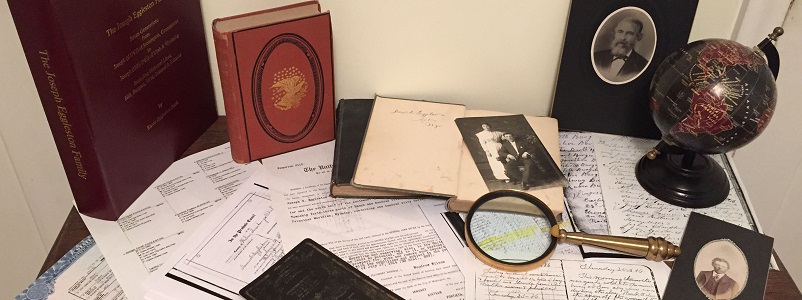On to Nauvoo, Illinois
The 2001 Eggleston Genealogy Odyssey continued after our visit to Winter Quarters and Council Bluffs, Iowa. After spending the night at a campground called “Sleepy Hollow”, Dad and I started early Monday August 5, and drove a few hours south from Iowa City. We crossed the Mississippi River on a Bridge by Fort Madison and drove into Nauvoo, Illinois from the east. What we saw was a small town on the bluff with some shops and houses and then right in front of us was the Nauvoo Temple under construction.
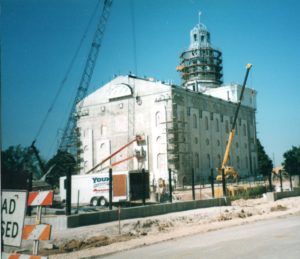
Nauvoo Temple under construction in 2001
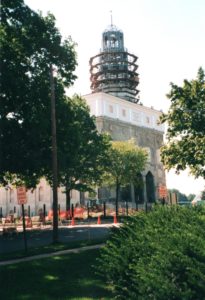
The Land Office
One of our first stops was the land office where we looked up where our ancestors had lived. We spent more time there than I expected and got quite a lot of information.
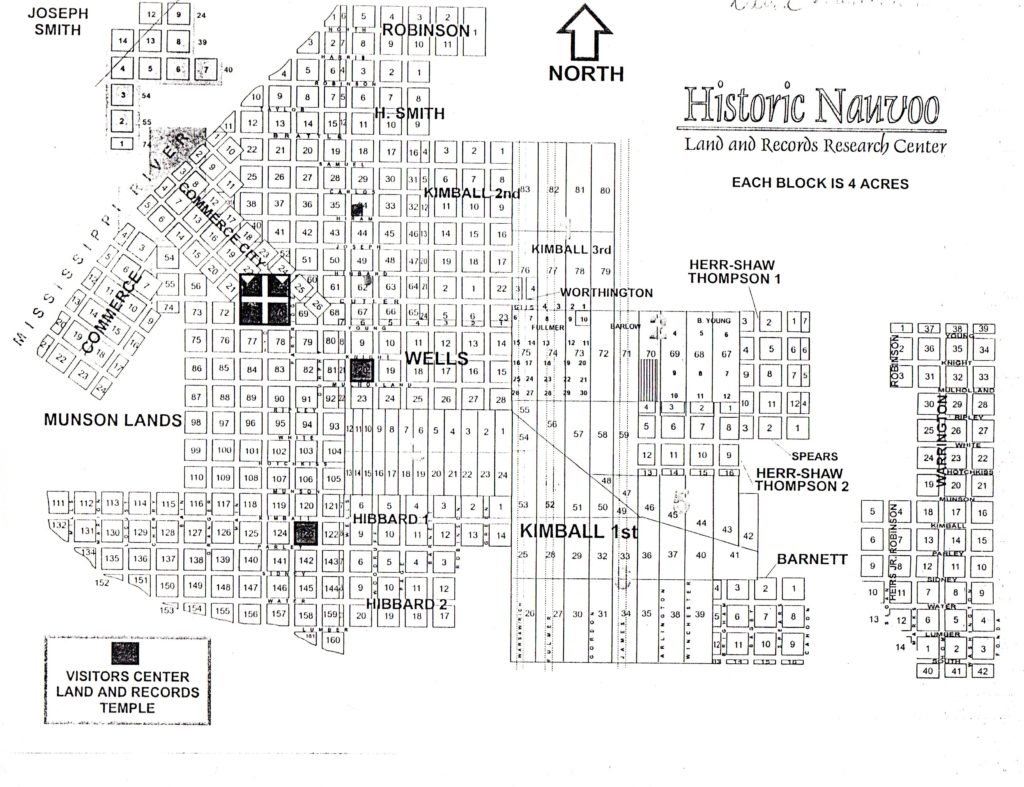
The Eggleston home on Block 62 and the Garlick home on Block 34. The Temple Block is the larger dark square in the Wells area
The Garlick home would have been a few blocks further beyond the trees in the photo below where it goes down into a gully. The Cheney family lived outside of town.
The Eggleston home
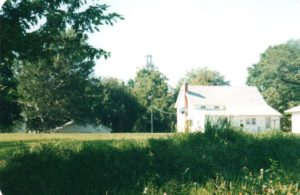
Scaffolding on the Temple in the middle of this shot from the area of the Eggleston home.

Looking toward where the land slopes down to a gully.
We found the lot where the Samuel Eggleston family lived (approximately). The Eggleston home in Nauvoo was located on Lot 1 of Block 62 on the corner of Hibbard and Woodruff Streets, only a few blocks north of the Temple site. Where this lot now sits, the street dead ends and there is a group of trees.
In August 2001, we could easily see the scaffolding on the tower of the Temple, then under reconstruction, from the Eggleston land. Depending on how many large trees were between them and the temple, Samuel and Lurania could have had a good view of the Temple being built. They may have been able to hear the sounds of construction from their home. Certainly it was a very short walk for Samuel to go there to help with the building. Their lot would have been large enough for a garden, but Samuel did not have sufficient land to farm in or outside of the city.
Shoemaker Shop
We went to main street and started with the Boot and Shoe Shop. One of the missionaries there mentioned that he was from Castle Dale, Utah and Dad had to ask if he knew about Wilsonville. He said his brother owns it. We had a nice discussion about Wilsonville. At another place there was a missionary who knew Mormon Row and had stayed at the Moulton’s place and looked at Grandpa’s collapsed cabin. It is a small world.
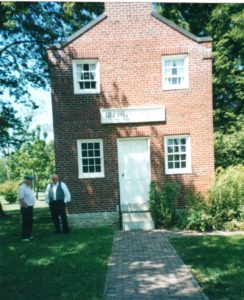
My Dad talking to the docent in front of the Shoe Shop
The shoemaking demonstration was very interesting. I kept thinking about Samuel. He was a shoemaker so the things we saw demonstrated would have been his daily work. At that time, shoemaking was quite an involved process. Besides the tanning of the leather, it included woodworking in making wooden shoe lasts and small wooden pegs with which to fasten on the soles, as well as the cutting and sewing of the leather pieces into shoes.
There were about six shoemaker shops in Nauvoo. Six shoemakers worked in this particular shop. It is likely that Samuel worked worked in such a shop with others, rather than having one of his own, though he could have worked out of his home.
In 1845 the “Tanners and Shoemakers Association” was formed in Nauvoo. It later expanded to include harnessmakers. They operated a tannery on Hibbard and Rich Streets near Colton’s brick yard, and a Boot, Shoe, Saddle and Harness Shop on Mulholland Street. The Association advertised in April 1845 for business as well as for calf-skins. Samuel very likely was a member of this Association and may have worked in the tannery or Boot and Shoe Shop.
Around Town
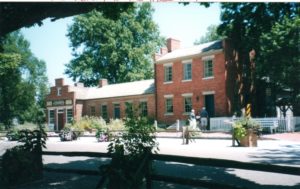
The Browning home and Gun Shop
We went to the Browning House and gun shop. It was interesting because we know the Browning family. They settled in Ogden, Utah. We learned some family history as well as information about the making of guns. I am pretty dumb about guns, so it was a learning experience for me. We also ran in to people we knew from home there. Small world again.
We visited the brick yard where we saw the process of making bricks. The Log School, the Tin Shop and the Bakery were interesting places we stopped. The Lyon Drug store was quite a large store with not only drugs but other typical articles that would have been in a general store. Our ancestors probably shopped there. An herb garden was outside which would have supplied many of the “drugs” in the store. The Lyons who owned this store were in-laws of Patty Sessions, the midwife who delivered Samuel Jr. in Winter Quarters. The log cabin next to the store was her home.
I must mention that it was very hot and humid. It was quite miserable being outside there. I thought it very interesting that these “restored” and reconstructed building which we were told had been build as the originals with the kinds of tools they had then and furnished with period furnishings, etc., all had AIR CONDITIONING. It was heaven to go inside. I was so glad they didn’t want to be so authentic as to make us tourists sweat.
Post office and Printing Office
The Post Office was of interest to me because we seem to have a history of Postal Work in our family. My grandfather Joseph Eggleston carried mail in Jackson Hole and had the Post Office in his home on Mormon Row. Selar Cheney had the Post Office in South Park named after him. Orson Hyde Eggleston was the Postmaster in Eden, Utah, and Samuel Eggleston was Deputy Postmaster in Pottawatamie County, Iowa. Sylvester Wilson had a Post Office at Wilsonville, Utah along the Old Spanish Trail.
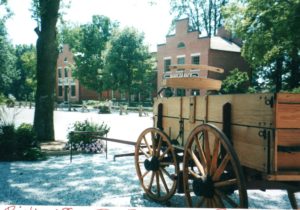
The Printing Office and the Post Office behind the wagon
At the Post office they had the pigeonhole cabinet where letters were. They showed how they wrote both ways and folded the page into an envelop to conserve valuable paper. Postage was based on how far it was sent and it was usually sent postage due. It was expensive for the time so they were conservative.
The Printing Office showed the cases of type and how type was set then the page printed. It was interesting to think of Reuben and Orson Eggleston working in such a place, doing the tedious work of setting type.
Seventies Hall
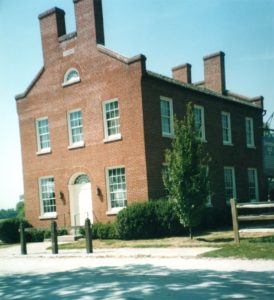
Seventies Hall
After walking through town we drove over to the Seventies Hall. It was quite an impressive building and we learned about it’s construction as well as about the purpose of it—to train missionaries. Upstairs were displays of artifacts that had been found as the restoration projects were done – lots of broken pottery and bottles. They told us that there had been a root cellar at Brigham Young’s home, which was basically a garbage dump after they built a new one attached to the house. Some of the broken dishes found were later glued together and now are displayed at his home.
We were able to look up ancestors who were seventies in the indexes and found some information about them. Most of this information was also at the Land and Records Office.
Samuel Eggleston, who was a Member of the Ninth Quorum of the Seventy. In the fall of 1844 several new Quorums of the Seventy were organized. The Ninth Quorum of Seventy was organized October 8, 1844. Samuel was ordained in October 1844, which was probably at the time this Quorum was organized. He is toward the beginning of the list of members. The Ninth Quorum recorded its first meeting October 16, 1844 in the Seventies Hall. Meeting notes included mention in most meetings of the members “speaking their feelings”.
Blacksmith Shop
Next to the Seventies Hall was the Blacksmith and Wheelwright Shop. We learned how a wagon and especially the wheels were made. When the Saints were preparing to leave Nauvoo, this was a major business and they had to work very quickly. At the Blacksmith shop the missionary actually made a small horseshoe while we watched and he talked. The term “smith’ refers to the smiting of metal. The term blacksmith apparently came from the process of dunking the shaped metal into horse manure or today oil is used, which turns it black.
I couldn’t help but try to imagine the Garlick family living in an abandoned blacksmith shop their first winter in Nauvoo.
Memorial Gazebo
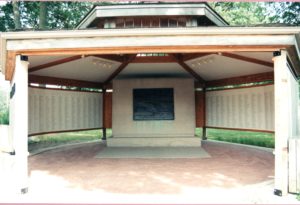
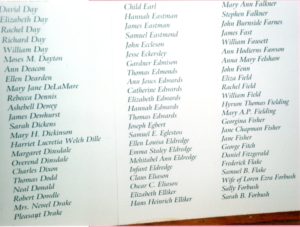
Samuel Eggleston in the middle column
From there we went down to the river. There were water lillies floating on the water which were just beautiful. It really was a lovely and peaceful place. There is a Gazebo there with the names of people who died on the way west. Samuel Eggleston Jr. is listed there, as he died in Winter Quarters.
Other Visits and Activities
Though family history was one purpose of our trip, we were also very interested in L. D. S. Church History. So we of course saw all that there was to see and did all that we could fit in during our short trip. We went through homes of Brigham Young and some of the other Church leaders. We spent some time at the Red Brick store where the Relief Society was organized. A collection of artifacts which had been found in the city was on display there. We then went to the Mansion House and the Homestead where Joseph Smith and his family had lived.
The Missionaries presented a musical about the old days of Nauvoo in the Cultural Hall, which was very entertaining. Later in the evening we enjoyed the “Sunset on the Mississippi” program. There was a actually a very beautiful sunset, but it came with bugs. This really is a beautiful place and must have been so sad for our ancestors to have to leave their homes here.
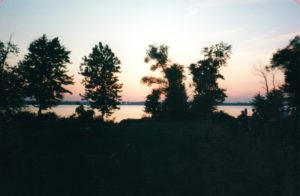
We spent the night in the Nauvoo State Park Campground. In the morning we drove out to the Old Nauvoo Burial Ground. It is very peaceful out there and we were alone except for one small group who joined us for part of the time. Very few of the graves are identified, and many of the existing stones are broken, but there is a Gazebo with all the names. David Garlick died in Nauvoo and his name is on the monument. We were surprised that this cemetery was out of town as far as it was. They would have had lengthy funeral processions.
We then drove to Carthage to visit the Jail and Visitor’s Center there, before heading further east.
